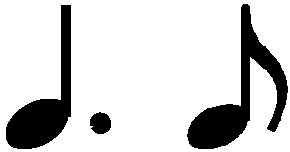



Issues : Dotted rhythms and triplets
|
b. 51
|
composition: Op. 27 No 1, Nocturne in C# minor
..
In bar 51 of GE (→FE→EE) the semiquaver in category imprint: Interpretations within context issues: GE revisions , Dotted rhythms and triplets |
|||||
|
b. 51
|
composition: Op. 27 No 1, Nocturne in C# minor
..
In GE (→FE) notes of the R.H. rhythm category imprint: Interpretations within context; Differences between sources issues: EE revisions , GE revisions , Dotted rhythms and triplets |
|||||
|
b. 51-53
|
composition: Op. 2, Variations, complete
..
On the 2nd beat of each of these bars, the R.H. top voice is written down in AsI in twice as long rhythmic values than suggested by the time signature and the relation to the bottom voice: category imprint: Interpretations within context; Differences between sources; Source & stylistic information issues: Dotted rhythms and triplets |
|||||
|
b. 53-62
|
composition: Op. 27 No 1, Nocturne in C# minor
..
In GE (→FE) in bars 53-62, similarly to GE in bars 29-36, notes of the R.H. rhythm category imprint: Interpretations within context; Differences between sources |
|||||
|
b. 77-82
|
composition: Op. 49, Fantaisie in F minor
..
Moving the semiquavers in bars 77-78 and 81-82 beyond the 3rd quaver of the respective L.H. triplet is an arbitrary change by the revisers of GE and EE (in bar 77 GE mistakenly placed the semiquaver before the 3rd L.H. quaver). It suggests that the semiquavers should be performed after the respective accompaniment note, which is certainly contrary to Chopin's intention, clearly stated in the A notation. Cf. bars 245-249, see also the Nocturne in C category imprint: Differences between sources issues: EE revisions , GE revisions , Dotted rhythms and triplets |



 was moved beyond the 3rd note of the triplet in the accompaniment. This inauthentic, misleading notation was used throughout the Nocturne.
was moved beyond the 3rd note of the triplet in the accompaniment. This inauthentic, misleading notation was used throughout the Nocturne.

 are distributed in such a way that the quaver is aligned with the 6th L.H. note. In the editors' opinion, this probably does not reflect Chopin's intention but we cannot state it definitely without [A]. The rhythmical structure of the bar, different e.g. from that in bars 29-36 & 53-62, as well as the local climax ending in this bar make a possible exception slightly more likely here. In the main text, we apply the regular rhythmic notation, so did
are distributed in such a way that the quaver is aligned with the 6th L.H. note. In the editors' opinion, this probably does not reflect Chopin's intention but we cannot state it definitely without [A]. The rhythmical structure of the bar, different e.g. from that in bars 29-36 & 53-62, as well as the local climax ending in this bar make a possible exception slightly more likely here. In the main text, we apply the regular rhythmic notation, so did 
 . Regardless of the mistake (cf. b. 45-46), it definitely means that the last notes of both voices should be performed simultaneously. However, a change introduced into
. Regardless of the mistake (cf. b. 45-46), it definitely means that the last notes of both voices should be performed simultaneously. However, a change introduced into  .
.


 minor, Op. 27
minor, Op. 27